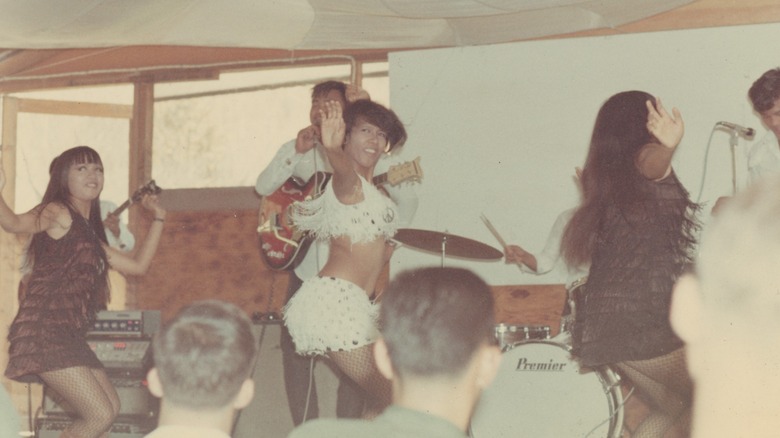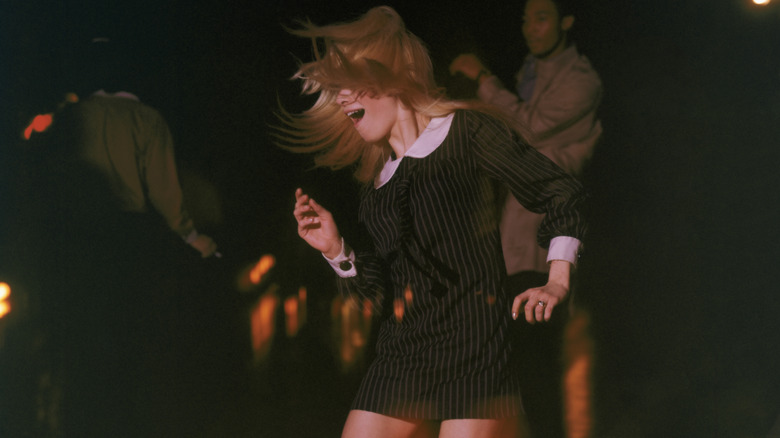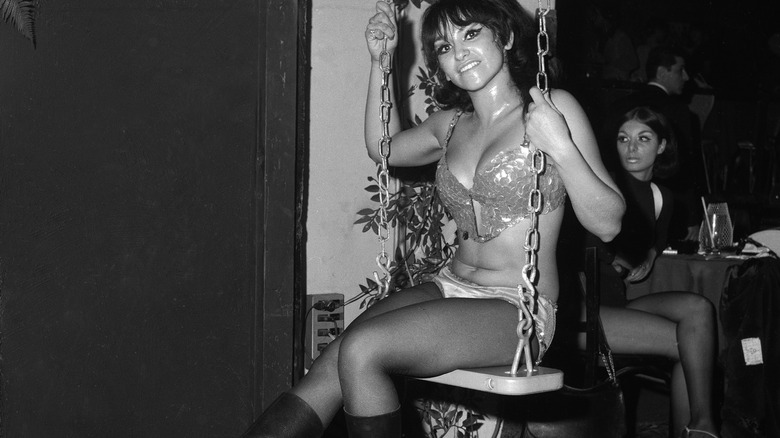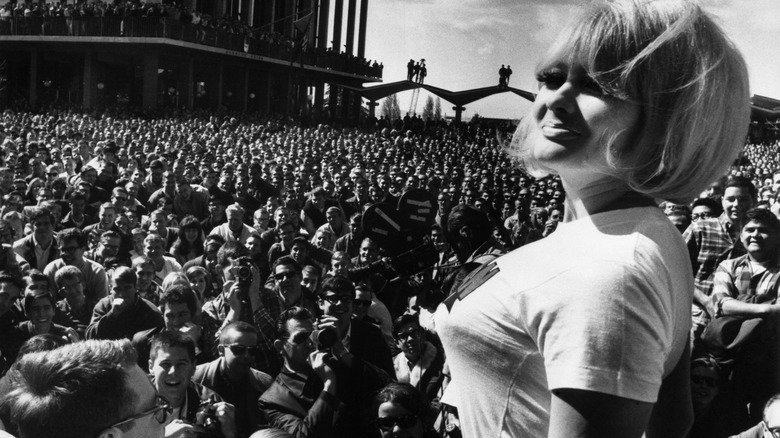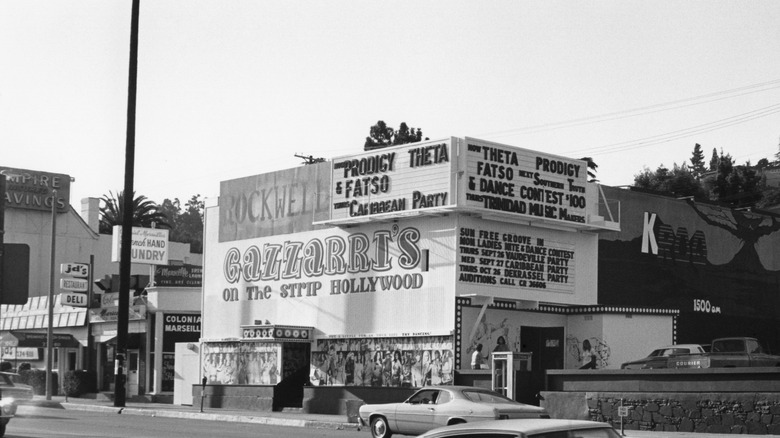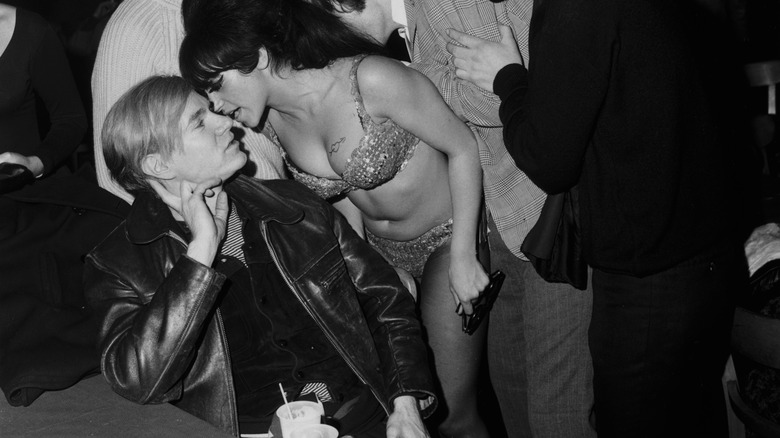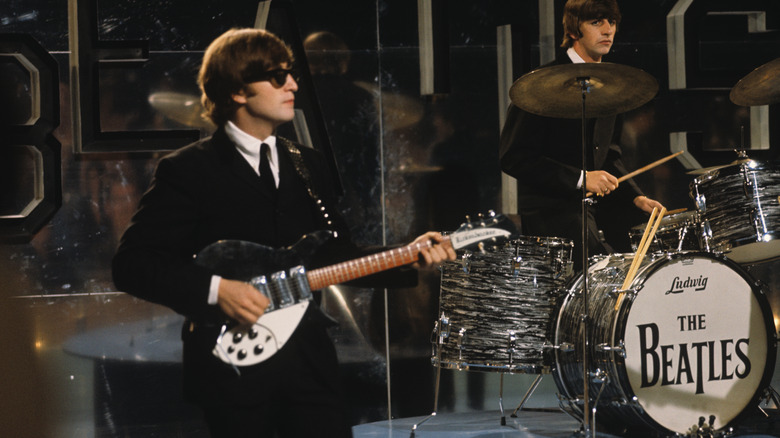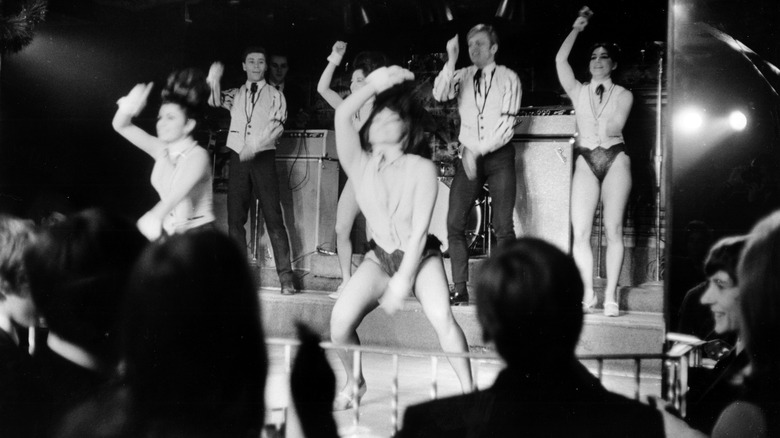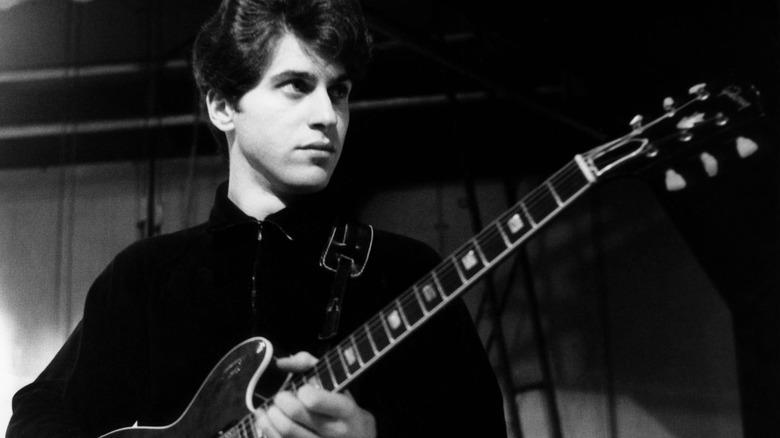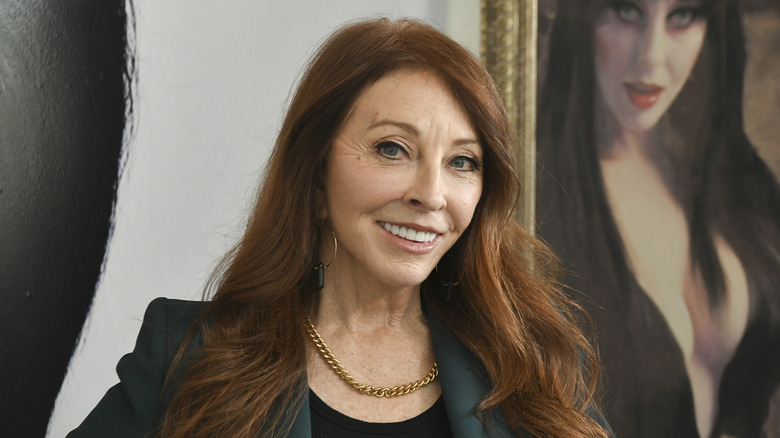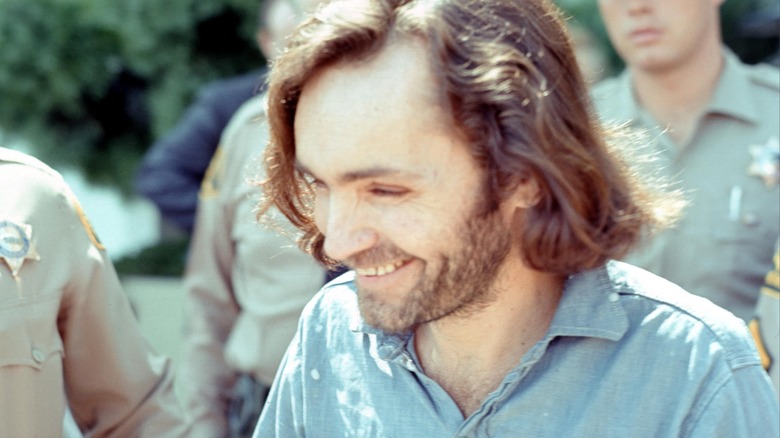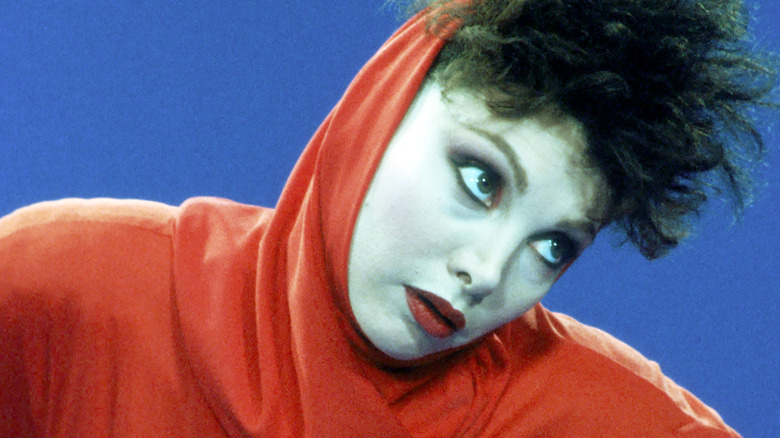What It Was Really Like Being A Go-Go Dancer In The 1960s
The revolutionary dance clubs of the 1960s were perhaps most hilariously summed up by The Saturday Evening Post's Norman Poirier. He was writing in the heyday of the Swingin' Sixties, and in 1965, observed that the club scene was "a noisy national madness that the anthropologists of the 21st century will find difficulty in explaining." Clearly, he had no idea what was in store.
At the time, the free-style, high-energy dancing to this new music called rock 'n roll presented something of a challenge for the old guard. Dancing had long been a dignified, serious affair, and with the release of Chubby Checker's "The Twist," as Bob Dylan said, "The times, they are a-changin'."
Go-go dancing is a little unusual when it comes to history, because it's generally agreed exactly when it became an American thing and who came up with the idea of scantily-clad dancers twisting the night away... usually on raised platforms or in cages. After a police officer-turned-nightclub owner named Elmer Valentine opened a joint called Whisky a Go Go, he first made a practical decision: Suspend the DJ booth from the ceiling, to make the most of limited floor space. From there, he hit upon the idea of a female DJ, ultimately ordering a cigarette girl named Patty Brockhurst into the booth. When she started dancing along to the music she was playing, the rest is history — and a new type of entertainer was born. So, what was the view like from up in the rafters?
Go-go dancers viewed themselves as wildly liberated
To put the phenomenon that was go-go dancing into the proper perspective, it's necessary to jump back in time a bit. Before go-go, dancing was precise. More than a little uptight. Proper. Restrained. Then, as a dance instructor named "Killer Joe" Piro told The Saturday Evening Post in 1965, go-go changed the game: "The girl is free to do what she wants to. She couldn't let herself go before the Twist. They must have been swearing under their breath for years — led around, pushed around, held down. Now they can be as wild as they feel."
It was the men, Piro said, who struggled with this new form of dance and the idea that in order to have fun, sometimes you just have to let your hair down and go where the music takes you. But along with that freedom was something else, and as Gloria Steinem explained to The Wall Street Journal, it was also pretty revolutionary that now, women didn't need a male dance partner.
Go-go dancers were showing women how to hit the dance floor and have fun, either solo or with other women. The bonus? Steinem says that it also stopped them from "worrying about wandering hands." Historian Stephanie Coontz agreed, saying that it took away a huge part of the stigma of cutting loose in public. "Go-go dancing initially allowed young women to rebel against the repressive 'bad girl-good girl' double standard of the 1950s."
Go-go dancers experienced a shift in the culture as the decade wore on
While early go-go dancers were able to experience the dance floor — and their views from above it — as a liberating experience that women simply hadn't had before, it wasn't long before the whole thing soured. After just a few years, the idea was co-opted by the powers-that-be and turned into a way to attract male audiences, viewers, clients, club-goers, and patrons. Scantily-clad go-go dancers became a hallmark of the era's popular music and variety shows: Stripped of personality and intellect, they were often reduced to a sexist, objectified joke made on behalf of male hosts.
Meanwhile, go-go dancing branched off into a few very different areas, perhaps best described as "PG" and "X." A 1973 piece in The New York Times pinpointed the moment that it happened, when "a thin-chested cocktail waitress from the Napa Valley was persuaded by an immensely fat press agent named Davey Rosenberg to take off her clothing above the waist and dance at a go-go joint." That waitress was Carol Doda, and she effectively bridged the gap between the family-friendly dancers that appeared on televisions across the nation and more adult clubs.
Her topless performances at the Condor didn't just catch the eye of tourists, but it also got the attention of the police. They raided the place, and it led to an obscenity trial. The outcome of the trial found her innocent, led to the legalization of topless dancing, and the blurring of lines between stripping and go-go dancing.
Some dancers resorted to dangerous medical procedures to accent their features
It was Carol Doda (pictured) who kicked off an era of adult entertainment with her topless go-go act, and when she passed away in 2015, The Washington Post looked back at the influence she had on the nation's entertainment landscape. They noted that she was once called "the Susan B. Anthony of this particular liberating movement," while she was a little more practical about things: "It was my only way to get in show business. So, I showed my business."
Doda, it turns out, had been pressured into undergoing not just a few cosmetic procedures, but 44 of them: UPI described the number of silicone injections put into her breasts as "an unusually large dose," and if that sounds like maybe not a good idea, it's worth mentioning that yes, it was incredibly dangerous.
A 2009 article in the journal Pulsus Plastic Surgery looked at the potential for major complications. Silicone injections grew increasingly popular as the 1960s wore on, but by 1965, women were starting to suffer severe complications from injections — thousands of which were done in Las Vegas — of non-regulated silicone. Things got so bad that transporting silicone across state lines became a felony in 1975, and it remains unclear how many women went through the procedure that in many cases led to things like the development of cysts. Doda often said she had no such complications, but pressure to undergo them from the powers-that-be? Not cool.
Being part of a go-go troupe could be cutthroat
"Hollywood a Go Go" was one of the era's many musical variety shows, and it ran between 1964 and 1966. Along with some of the top music acts of the time, it featured the Gazzarri Dancers, named for the club where core members De De Mollner and Mimi Machu were discovered (pictured, in 1973). Mollner and Machu were in every episode, and when Mollner spoke with the blog Holy Go-Go Boots, Batman!, she said that while there were a few other long-timers, "We went through a lot of people. That's how it is: ... There were always girls coming and going, who never clicked, so we just had a little clique of our own."
Mollner said that perhaps surprisingly, showrunners gave little thought to the dancers. There was no one telling them what to wear or how to dance, so they needed to take that all on themselves. "It's so interesting when I think of it now. We really did whatever we wanted. It was amazing... No one was promoting us on that show at all. These days, of course, we'd have our own line of clothing but then, we had nothing."
That came with a caveat, though. Mollner explained that she and Machu found themselves running the troupe of a half-dozen dancers, for better or worse. Girls they liked were in, but if there were conflicts or disagreements, the problem girls were out and there was always someone waiting to take their place.
Some got up close and personal with some big names in music
Go-go dancers performing on television shows and in some of the biggest clubs in the country were dancing behind some of the biggest names in music, so did they get to meet them? Absolutely: Gazzarri dancer De De Mollner says (via Holy Go-Go Boots, Batman!) that she was dating The Byrds' Michael Clark at the same time she was performing on "Hollywood a Go Go," and not only met some of the acts, but she says that she became good friends with Tina Turner. A few years after the end of the show, she was in London and met up with the Rolling Stones, Cat Stevens, and Patti D'Arbanville.
"Hullabaloo" go-go dancer Lada St. Edmund hung out with The Beatles and the Rolling Stones, appeared on "The Tonight Show," and met scores of people from across the entertainment industry — including Burt Reynolds, who got her into stunt work. (She was Sally Field's stunt double in "Smokey and the Bandit.")
Some go-go dancers were there from the genesis of groups, too. June Fairchild dated Danny Hutton for a time, and she often claimed that she was the one who suggested the name for his eventual group: Three Dog Night. Meanwhile, Maggie Cowart — go-go dancer and darling of the Austin, Texas club scene — revealed to author Michael Corcoran that she was hanging out with Bob Dylan, the Chevelles, and was even credited with introducing Don Henley and Kenny Rogers.
Yes, drugs were involved
It's no secret that drugs — particularly psychedelics like LSD — helped shape the culture of the 1960s in a big way. The widely accepted, oft-told story is that John Lennon and George Harrison were the first to try it when they — along with their wives — had their drinks spiked by so-called friends. According to what Gazzari go-go dancer De De Mollner told Holy Go-Go Boots, Batman!, she'd actually gotten there first.
Mollner claimed that she'd been on acid when she met The Beatles (and had been under the influence when she filmed some episodes of "Hollywood a Go Go." Lennon, she said, had wanted to try some. "So I went back and gave it to him," she said. "I never talked to him again but I know he took it. Ringo became one of my neighbors later, but he wasn't even involved in this. That's all I can tell you..."
That's certainly a tantalizing bit of rock history, but not all go-go dancers have such iconic memories of drug use. In 2015, the Los Angeles Times reported on the death of 68-year-old June Fairchild. She had been a well-known go-go dancer in LA who tried to transition into movies, but it didn't work: Drug and alcohol use torpedoed her career, and she was quoted as describing herself as "an angel in a snake pit." After struggles maintaining sobriety and several attempts at rehab, she ended up living on the city's Skid Row and died of liver cancer.
Some of the most famous were rubbing elbows with the mob... even if they didn't know it
A former police officer from Chicago, Elmer Valentine was upfront about the fact that he was absolutely on the take, had friends in the mob, and that those friends had followed him to California once they realized he had a pretty sweet thing going there. That thing was, of course, Whisky a Go Go, and it's worth noting that Valentine had gotten his first nightclub experiences in mob-run joints.
One of his closest friends was a hit man named Felix Alderisio, who was around the Whisky from the beginning. "Milwaukee Phill would chin himself on the go-go cage as it was being built," he told Vanity Fair, and if that's not a 60s-era fond memory, then nothing is. Competition was steep: Bill Gazzarri — boss of the Gazzarri go-go dancers — had his own mafia heavyweight who was recruited to try to get Rivers back to his club, and Valentine ordered his muscle to put an end to it.
Over on the East Coast, things were pretty similar. The Peppermint Lounge was credited with taking go-go dancers to New York, and the club also just happened to belong to the Genovese crime family. It, says the Los Angeles Times, went from mob front to massive hit — and they quoted NYT columnist Arthur Gelb as complaining, "Cafe society has not gone slumming with such energy since its forays into Harlem in the twenties."
Musicians and dancers worked together... mostly
De De Mollner, a go-go dancer on "Hollywood a Go Go," told the blog "Holy Go-Go Boots, Batman!" that she was always thrilled when she would get comments from people who understood what it was they were doing: "I've had people who watched the show and saw us dancing, they say, 'We just feel the energy.' And that to me is so great, because that's all it was. It was so real, it was so unconscious." Conflict, however, was inevitable.
Johnny Rivers (pictured) was the resident artist at Whisky a Go Go in the early days, and in an interview with Vanity Fair, he made it clear that he didn't appreciate the dancers. In fact, he put his foot down about it: "I said, 'When I'm playing, I want people to listen to my music. I don't want any sideshows." And he wasn't the only performer to clash with the girls.
In 2016, Robby Krieger spoke with People around the release of some early Doors' tracks. They were recorded at a nearby club called London Fog, and Krieger said although it was less of a dance club than nearby venues, they still had a single go-go dancer named Rhonda Lane. Others would occasionally be hired for the night, and he said that one had the misfortune to try to dance during Doors' classic, "The End": "She was getting more p****d off as it went along. And at the end, she went, 'Never play that song again when I'm dancing!'"
Elvira got her start with the help of her go-go dancing agent
Go-go dancers were in high demand, so much so that agents worked with matching girls up with gigs. That's a little tidbit of information that was dropped by Cassandra Peterson during a BUILD Series interview, and yes, that's Elvira, Mistress of the Dark. When she heard they were looking for someone to be the "Hullabaloo Girl," she auditioned and danced her way right into second place. Along with a full wardrobe, she was also given a contract to dance in a Colorado Springs nightclub. She absolutely loved it, got herself an agent, and continued dancing all across the area.
"I wasn't 16 yet, but I would get in my car and drive to like, North Dakota! I had no license," she laughed. "But I had a go-go dancer agent. ... I almost got killed a million times in blizzards," she said, adding that she was actually only 14 when she was booked all across different states to dance in hotels, bars, and clubs... including officers' clubs on military bases. "That's how I made my summer money as a kid!"
She shared a little more information with Gay Calgary, and revealed that even though the typical image of a 1960s go-go dancer involves tall boots and short skirts, that wasn't always the case. She said that when she was hired by the military base, she was also dancing at a nearby gay bar with two other male go-go dancers. "We did the Supremes. ... Isn't that scary?"
Run-ins with Charles Manson
While go-go dancing may have captured the fun, liberated spirit of the 1960s, there was something else brewing in the decade, too — and a surprising number of dancers have spoken about how they ended up crossing paths with Charles Manson. Manson famously saw himself as an often- and wrongly-rejected musician, so it kind of makes sense that he would frequent all the hottest clubs in his area. That included Whisky a Go Go — and according to former manager Mario Maglieri, he kicked Manson out of the club after a call from his secretary, who was worried about this really strange dude.
He told Vanity Fair, and when he told Manson to get the heck out, "He looked at me and says, 'I can have you killed.' And I f*****g grabbed him. ... I should strangled that son of a b****."
Gazzarri dancer De De Mollner told "Holy Go-Go Boots, Batman!" that she was friends with the owner of the house where Sharon Tate and her friends would ultimately die: After the killings took place, she said that she and her fellow dancer, Mimi Machu, tried screaming at their house to see if anyone would show up to see what was going on. "No one came. ... We were terrified, because these were our friends that had been killed, and we had no idea who'd done it." Toni Basil, too, told Today that she had known Sharon Tate, and when she worked on "Once a Time in Hollywood," it was an eerie step back in time.
Some tried to make the jump into movies and television
While Cassandra Peterson is perhaps the most high-profile go-go dancer to make the jump into mainstream television and movies, others used the connections they made and their experience in the industry to continue performing long after the go-go trend had hung up those boots. Jacqui Landrum, for instance, was one of the girls dancing on "Hollywood a Go Go" with De De Mollner, and — as Mollner told "Holy Go-Go Boots, Batman!" — picking up guys in their Corvettes.
Landrum died in 2008, and according to her obituary, she and her husband, Bill, worked as instructors and choreographers for television shows like "Moonlighting," and movies like "The Big Lebowski." Meanwhile, "Hullabaloo" go-go dancer Lada St. Edmund was told that getting serious work as an actress with "go-go dancer" on her resume was going to be difficult, so she got into stunt work instead.
Toni "Hey, Mickey!" Basil (pictured) was on the go-go scene, too, as choreographer for "Shindig" and in front of the camera for movies including Elvis's "Viva Las Vegas." That made her the logical choice for Quentin Tarantino to call when he needed someone to choreograph "Once Upon a Time... in Hollywood," but not everyone has been so successful. "Hollywood a Go Go" dancer June Fairchild's brief movie career was derailed by drug and alcohol abuse, and although Mollner scored roles in movies alongside Dennis Hopper and Jack Nicholson, those parts were ultimately cut and her showbiz career fizzled.
